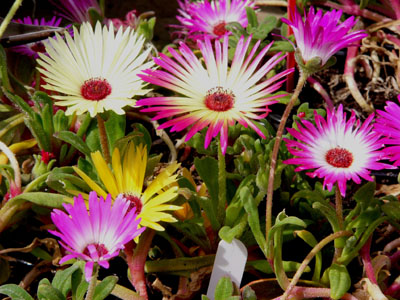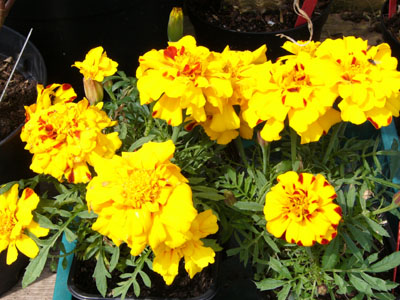Growing in the Air
Tracy Wilson suggests plants for seaside hanging baskets
11th May, 2007
If you divide �plants for the garden� into almost �bodily parts�, you can think of trees as being the backbone, shrubs as being the rest of the skeleton; perennials provide the flesh and then your annuals generally giving you the make-up � they�re the bit that gives you the instant colour, the sex appeal, the clothes, if you like. So for most people with a coastal garden, the temptation is to go tripping off to your favourite nursery garden centre, and you see things that are already starting to flower and you think �Right, that�d be great, they�ll look nice, I�ll take some of those.� You wil be sadly, sadly disappointed when the first gale comes along and they literally get blackened. It can be really very depressing. But there is a good range of annuals which will tolerate quite severe coastal exposure and in fact do quite well. It�s really a case of looking at the ones that won�t enjoy those sorts of conditions � which plants to avoid � and then how to look after the rest so that you�re going to get the best out of them within the year by increasing or extending the flowering period and make life easy for yourself. This is particularly a concern for hanging baskets which, even given the most sheltered of positions, are vulnerable. If you have them hanging off a house overlooking the north Cornwall coast then suddenly, oh boy, have you got a whole new ballgame to play! So you do have to choose carefully what you�re going to have.
 Mesembryanthemum
Mesembryanthemum
 French Marigolds
French Marigolds
When it comes to trailing plants, I know people like to have quite long, trailing effect out of the basket. Ivy is always a popular to go for. Yes, it is slowish growing, but bear in mind that you can recycle it! You could have a winter hanging basket or you could save it for the following year. There�s a lovely plant that�s relatively new called Dichondra �Silver Falls�. It has a leaf which is sort of like a round heart-shaped leaf and it will hang rather like Nepeta � it�s almost like dreadlocks for hanging baskets, really! It�s gorgeous, with a lovely softly hairy leaf with a really silver sheen to it, extremely pretty. There is a plain, green-leafed form as well but the silver one is particularly attractive. And of course, there is Nepeta � and I�m not talking here about the Catnip version of Nepeta � I mean the pretty, variegated form, it�s actually called Nepeta glechoma and again, long dreadlocks hang down the basket, looking very effective. Be careful, if you do use those ones in the basket, to balance them up, otherwise your basket will look like a rather fat pussycat hanging in the air with a big long tail hanging off one end � make sure you hang them on each side, with two or three in the basket, so you get a very good effect with those ones.
So, that�s the main annuals. Now we go on to what I think of as the �body� plants, things like Fuchsias and Geraniums are excellent too for that, and the very well-known coastal plants, ivy-leaved Geraniums – , the ordinary upright ones. Fuchsias are brilliant. There is also a big range of basket plants which you can get now, grown as tender perennials � huge range, things like, again, Verbenas that come from cuttings. These ones usually come in individual pots so that you really can colour-coordinate your basket. They�re a little bit dearer, but they�re perennials so if you�ve got green fingers you can take your own cuttings and keep them going from year to year without too much problem.
I suppose my final hint for anybody doing a hanging basket, but most especially in a dry, coastal area, would be to make sure you incorporate water-retaining crystals in the compost: they�re sold under a couple of trade names, �Swell Gel� is probably the most popular one, but you�ll also find 'Hanging Basket Water Gel.' What you do is mix it with compost, you plant your basket up, then you give your basket a really good drink and leave it for an hour and then come back and give it another really good drink, by which time the crystals are charged up and then you give the basket another good soak. Don’t, please don’t, be tempted to put more in your basket than it says on the packet! You may think you’re actually doing yourself a favour by putting more in, but I know somebody who had done their basket and then decided, when they were mixing their compost and mixing the Swel Gel crystals in, that it was such a good idea to use twice as much as it said on the packet. This they duly did and then theyy watered it according to the instructions and walked away. When they came back an hour later it looked as if a mole had erupted in their hanging basket! Of course as the crystals had swollen up to ten times their size, there wasn�t room for everything in the basket and something had to give... everything had got pushed out of the pot. It was a very good lesson in �you can have too much of a good thing�. So don�t use too much.
When it comes to feeding, you can feed with every watering but use half strength, don�t use it at full strength. Just keep pouring the feed in. Bear in mind that you�re hanging the plants up in a very alien environment: you�re sticking �em six feet off a wall where they�re going to catch all the wind around the roots, they�re going to dry out and they�re going to be in full wind and full sun (usually). It�s a very hostile environment and they�re going to need all the TLC you can give them.
© 2007 Tracy Wilson
